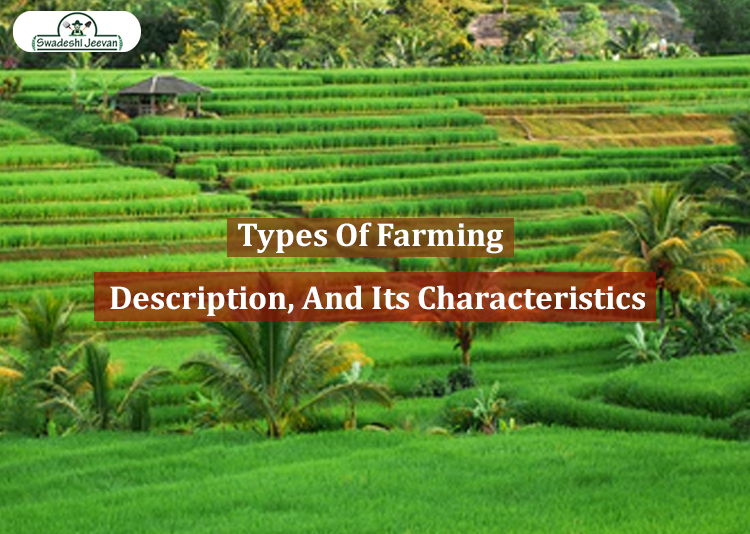Types Of Farming in India | Description And Its Characteristics.

Do you know the various types of farming is not only about ploughing and sowing seeds but consists of various ways that help in growing healthy and best crops? In the first place, the Kharif and rabi seasons are the two main seasons on which farming centrally depends.
Different types of farming methods are there to support agriculture even in changing seasons. Let's learn more about these Magical types of farming.
Read More: Mushroom Farming in India | Swadeshi Jeevan
What are the Types of Farming?
There are the top 8 types of farming methods in India.
Subsistence Farming
It is the type of farming that fulfils the motive of farmer's self-sufficiency. Moreover, subsistence farming occurs principally to grow food crops to meet their family's needs and their families on the smallholding.
Notably, this planting decision meets the primary demand for family needs and then sells out for the market price. Significant features of subsistence farming:
- Expect a small land area.
- Limited amounts of crops are grown.
- Most of the cropping takes place manually, without any help from tools.
Plantation Farming
Plantation farming includes growing giant trees and bushes introduced by the British in the 19th century. It primarily refers to single crop orchards or crops such as tea, coffee, lime, oranges, apples, etc. The tropical climate and a good investment for the export business are must for plantation farming. Critical features of plantation agriculture:
- Crops are grown on large estates.
- Requires more labourers.
- The investment rate is high.
- These crops are grown for commercial purposes.
Shifting Agriculture
Tribals used to perform shifting agriculture. In this, a part of forest land is well cleaned, and then crops are grown. Moreover, this is only possible by removing trees, branches, trunks, and other weeds.
As a result, millets, wheat, maize, and corn are grown in this type of land. After harvesting successfully, tribal people used to burn the ground to make it fertile for the next farmer. The farmers move to another ground to repeat this process; indeed, it is also known as slash and burn agriculture. Significant features of shifting culture:
- Exercise only plant seeds here.
- It is one of the worst farming ways.
- Practising cultivation by destroying forest trees and plants.
Nomadic Herding
Exercising this type of farming needs in dry or semi-dry land. Areas, for instance, central Asia, Rajasthan, and Jammu, and Kashmir. Sheep, camels, yaks, and goats are primarily used animals in this type of farming. Meat, hides, wool, and milk are four significant products that we get from nomadic farming. Features of nomadic herding:
- The nomadic community consists of well-known territory as a matter of tradition.
- A wide range of animals stays all together in a different area.
Intensive Subsistence Farming
The word intensive refers to hard work. Ultimately it includes a small plot, fewer tools, and more labour. Also, the sun should be shiny, and the soil should be fertile. This permits the ground to stay productive for long. Rice is the major crop. Wheat, maize, pulses, and oilseeds are some of the other crops that grow by this type of farming. Features of intensive subsistence farming:
- Practised in a densely populated area.
- Yield as per unit area is high and less production happens.
- Labour intensive technique.
Commercial Farming
The primary goal behind commercial farming is to sell crops in the market in a reasonable amount. And exercising this type of farming requires high technology machinery. By and large, it needs a massive budget for innovative technologies that farmers use. Furthermore, there are three types of commercial farming:
Commercial Grain Farming:
It is an extensive and mechanized form of agriculture. It is highly specialized in growing a single crop. Thereupon cultivating wheat crops in this area in both seasons is common. Prominent features of commercial grain farming:
- Establishment of large farms.
- Using a High mechanism.
- High yield per man but low yield per acre.
Commercial Mixed Farming:
Mixed farming is moderate in size and grows fruitful crops such as wheat, barley, oats, or rye. Farmers also try crop rotation, growing root crops(potato or turnip) and legumes(peas, beans, or clover). Features of mixed commercial farming:
- Requires both organic and inorganic fertilizers.
- Uses high machinery.
- Crops are grown for commercial purposes.
Commercial Plantation Farming:
This type of farming allows only the growth of a single crop the entire year. It requires a large amount of capital and labour. Features of commercial plantation:
- A single crop is grown.
- It is grown in hilly areas like the northeastern states of India, cardamom hills of south India, and many other places to exercise this type of farming.
Home Farming
Home farming includes terrace farming, gardening, and many other farming methods practised in a small area. This farming can grow any fruit, vegetable, flowers in a small space with small tools. Henceforth both commercial and meaningful ways could be executed with the help of home farming.
Dry Farming
This type of farming requires dryland where expectations of rainfall are meagre. Farmers grow drought-resistant crops here. Sometimes there could be a drought in the agricultural land. Ultimately, expectations of yield are down here.
Moreover, in India, agriculture contributes up to 20% of GDP. As can be seen, it is the source of livelihood for many in India. Lastly, there are various types of farming methods, and each has its importance and goodness. These methods help to convert challenges into opportunities for farming.
Categories: Organic Farming
Attachments: